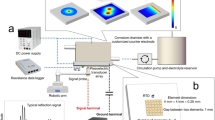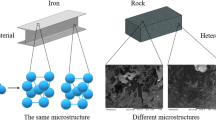Abstract
A CLEAVAGE crack propagating through a solid will also cut through the strain field associated with microscopic surface flaws, and this releases energy in the form of a stress pulse. If the material is elastically isotropic, this pulse will travel outwards from each flaw at a constant velocity in all directions, and the interaction of the stress pulse with the moving crack front will cause a slight localized deflexion of the crack. Thus a series of curved “Wallner lines”1 are produced, and these are easily visible on the fracture surface. Because the velocity of the stress pulse is a known constant for materials such as glass, the presence of these lines provides a simple method of measuring the cleavage velocity2,3. Kerkhof4 was the first to point out that, because the fracture surface can be modulated by a single stress pulse, it should also be possible to produce a series of faint permanent ripples on the fracture surface using ultrasonics. Knowing the frequency of oscillation, the velocity of fracture is obtained directly from the spacing between the ripples. This technique has been used successfully on glass5 and a polymer (polymethyl methacrylate (ref. 6 and private communication from K. Saito)), but its application to crystals with well defined cleavage planes is less obvious, for a large energy is then necessary to force the crack to deviate slightly from this plane. The method can be used on ionic crystals (magnesium oxide7, potassium chloride (private communication from M. Schinker)), and we report here the successful application of the technique to a metal.
This is a preview of subscription content, access via your institution
Access options
Subscribe to this journal
Receive 51 print issues and online access
$199.00 per year
only $3.90 per issue
Buy this article
- Purchase on Springer Link
- Instant access to full article PDF
Prices may be subject to local taxes which are calculated during checkout
Similar content being viewed by others
References
Wallner, H., Z. Phys., 114, 368 (1939).
Smekal, A., Glastechn. Ber., 23, 57 (1950).
Shand, E. B., J. Amer. Ceram. Soc., 37, 559 (1954).
Kerkhof, F., Naturwissenschaften, 40, 478 (1953).
Kerkhof, F., Glastechn. Ber., 33, 456 (1960).
Krafft, J. M., and Irwin, G. R., Fracture Toughness Testing and Its Applications, 114 (A.S.T.M., Philadelphia, 1964).
Field, J. E., and Heyes, A. D., Proc. Seventh Intern. Cong. High-Speed Photography (edit. by Helwich, O.), 391 (Zurich, 1965).
Hull, D., and Beardmore, P., Proc. First International Conf. on Fracture, 2, 629 (Sendai, Japan, 1965).
Author information
Authors and Affiliations
Rights and permissions
About this article
Cite this article
HEYES, A., LANGDON, T. Determination of the Cleavage Velocity in Tungsten using Ultrasonic Fractography. Nature 221, 168–169 (1969). https://doi.org/10.1038/221168a0
Received:
Issue Date:
DOI: https://doi.org/10.1038/221168a0
This article is cited by
-
The measurement of fracture speeds in silicon and germanium
International Journal of Fracture Mechanics (1972)
-
The measurement of fracture speeds in silicon and germanium
International Journal of Fracture Mechanics (1972)
Comments
By submitting a comment you agree to abide by our Terms and Community Guidelines. If you find something abusive or that does not comply with our terms or guidelines please flag it as inappropriate.



